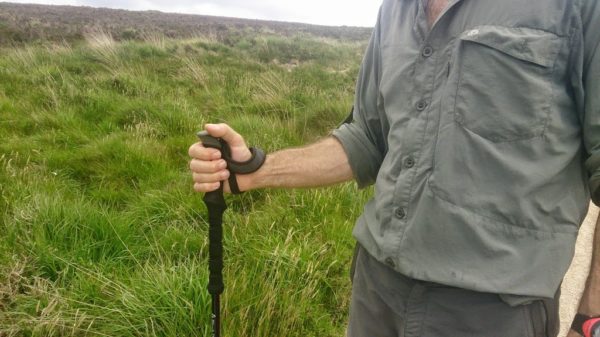Using hiking poles – Yes or No?

I regularly get asked by clients if using hiking poles is a good idea and my answer may sometimes sound noncommittal, ‘well maybe yes, maybe no’.
In reality it is down to the individual to determine whether hiking poles are for them. To help with making that decision I have laid out the major advantages and disadvantages below.
But first it is important to use the right technique when using poles, otherwise many of the advantages are lost. I see far too many hikers using poles incorrectly, to the point where they are doing more harm than good.
Adjust the length of the poles so that your forearm is at the horizonal when holding the grip. In cold weather you should shorten the poles slightly to have your hands lower than your elbows, this will help the circulation of warm blood into your fingers. You should also shorten the poles slightly when ascending steep ground, as you are placing them higher up the slope in front of you. Lengthen them again when descending steeply, as the ground is lower than your feet.
All this adjusting can be a chore, so clip-lock designs have a definite advantage over the twist-locking types.
Putting your hands though the straps as indicated will take a certain amount of strain off of your wrists. However, if you should take a tumble then the poles are flailing around your body, so some experienced users think it is better not to use the straps at all.
Keep the poles close to your body in both ascent and descent. Having your arms extended sideways so the poles act as stabilisers will not benefit your uphill and downhill progress, will ultimately reduce your ability to keep your balance and may act as a trip hazard for others around you.
In ascent use the poles slightly to the side or behind you, this will give added propulsion up the slope. On a steep descent, place the poles ahead of you, for support and braking.
One pole or two? This is a matter of personal preference, I often carry two poles but may only use one, leaving my other hand free to hold a map, camera or eat a snack! Long term use of only one pole has been suggested by some to cause imbalance issues with the muscles and ligaments.
ADVANTAGES
- Reduces the impact on joints, particularly in descent. Anyone with sore knees or lower body joint pain will benefit from using poles on downhill sections, it will also be of benefit to anyone carrying a heavy pack.
- If you find balancing difficult when travelling over rocky or uneven ground, at night or through deep snow, then poles will definitely be of benefit.
- Using poles correctly will give a whole body workout, reducing the work done by the legs and adding work to the muscles in the core, arms and shoulders. This has the effect of improving your power and endurance on long uphill sections.
- In river crossings a single pole can act as a ‘third leg’, increasing stability and safety.
- In boggy conditions a pole can be used to test the ground ahead, to check if it is solid and will support your weight.
DISADVANTAGES
- An incorrect technique can markedly decrease the value of using poles at all and can lead to muscle pain and injury.
- They can be an inconvenience if you need to free up your hands. Be prepared to put away your poles if you need to use your hands for scrambling, to read your map, or to navigate with your compass.
- Long term use of poles can lead to a decreased sense of balance, especially when used as ‘stabilisers’. Be prepared to put them away on flat ground and easy gentle slopes.
- Carrying hiking poles adds extra weight to your pack when they are not in use. When stowing your poles ensure the tips are pointing downwards so as not to risk them becoming a hazard to others. Poles are best stowed down the side of your pack, either inside or outside.
- The rubber tips on hiking poles often come off and consequently litter the hills, so leave them at home.
Russ Mills runs Mountaintrails.ie , a guided hiking and mountain skills training business based in Dublin.


